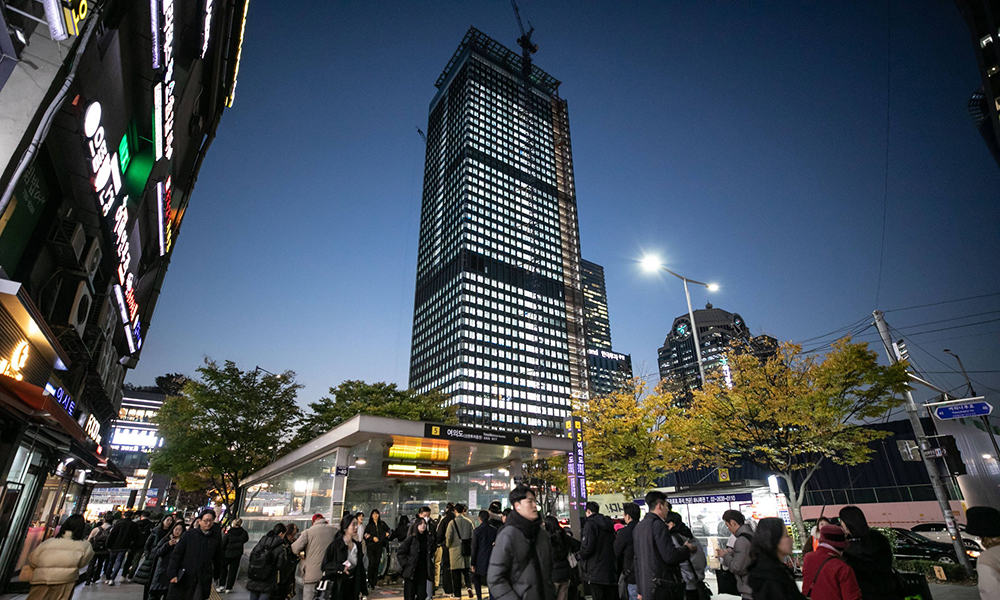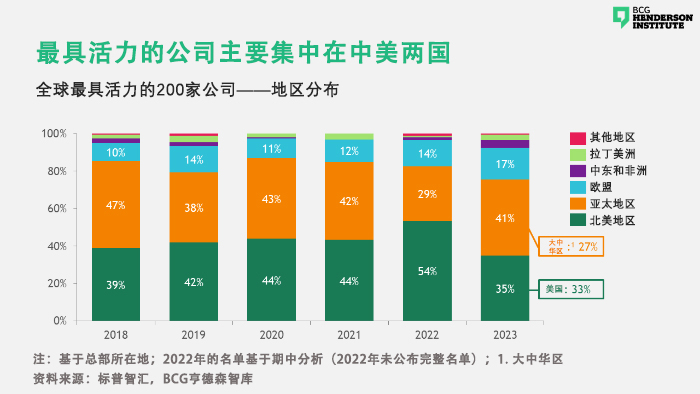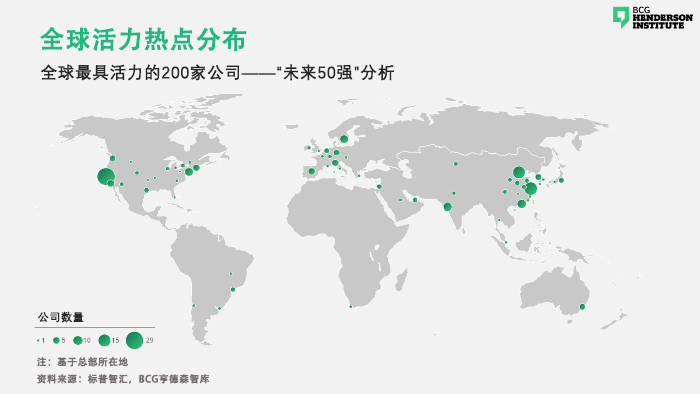未来十年的增长点在哪里?未来50强区域分析

增长是创造长期价值的关键,但确定具有增长潜力的行业或区域变得比以往更加困难,更不必说精确地找出有潜力的公司。例如,2022年,科技行业似乎陷入了困境,经历了大规模裁员和估值下降,在生成式人工智能热潮的刺激下才强势反弹。中国受到新冠疫情的影响,还陷入了与美国的贸易争端,但到2023年年底,中国的GDP增长速度在经合组织(OECD)国家中排在第二位。
2024年,地缘政治不稳定和战争、宏观经济环境的变化以及全球40个国家的选举,将继续引发局势动荡。为了帮助投资者评估未来的增长点,《财富》杂志和波士顿咨询集团(Boston Consulting Group)联合发布了“未来50强”(Future 50)年度排行榜,根据我们专有的AI驱动的“活力”指标,对上市公司进行排名。本文通过评估全球200家最有活力的公司,深入分析了增长潜力的地理分布。
增长潜力绝大部分来自中美两国
未来的企业增长潜力主要集中在美国,在全球200家最有活力的公司中,有33%位于美国。美国的科技行业占据主导地位,而且在2023年,美国经济顺利渡过难关,在维持GDP增长的同时降低了通胀,并维持了低失业率,因此美国依旧是全球经济增长的引擎。

大中华区紧随其后,全球200家最有活力的公司有27%来自中国。最后,欧洲地区的活力依旧远远落后,该地区的结构性弱点,如碎片化的消费者市场和有限的可用风投资本等,正因为发生在该地区的战争而进一步恶化。在200家最具活力的公司中,有17%来自欧洲,而且只有3家公司进入2023年的“未来50强”排行榜。
全球活力热点分布
在中美两国,有一些最具有活力的热点地区,其中排名靠前的公司主要都集中在两个“黄金海岸”,即美国西海岸,包括硅谷,以及中国的东海岸,包括上海/杭州和香港/深圳地区。

除了这两个区域以外,在全球还有一些较小的热点地区,集中了多家极具活力的公司,这证明实现增长不会受到地域的限制:
• 在欧洲,意大利和西班牙很有代表性,两国分别有6家和5家公司进入了最具活力的200家公司之列。在意大利,最具活力的公司中有多家金融科技公司,例如支付公司Nexi和在线银行与经纪商FinecoBank。虽然意大利在金融科技领域长期落后于欧洲其他国家,在2019年欧洲大陆吸引的投资中,意大利仅获得了2%,但这个差距已经开始大幅缩小。随着意大利消费者越来越多地通过移动解决方案满足资金需求,意大利的资金量暴增,预计交易价值将会大幅增长。
• 以色列有3家最具活力的公司,它们都来自科技行业,以色列已经成为科技行业的关键参与者。但在2023年,政治动荡和战争导致资金大幅减少,以色列初创公司将会面临挑战。
• 巴西今年的表现抢眼,有4家公司进入前200名,其中包括进入“未来50强”排行榜的巴西最大私立医院集团Rede D’Or São Luiz;位于圣保罗的股票交易所B3,它是拉丁美洲最大的股票交易所,散户投资者的投资热情高涨和更多境外资金流入巴西,将令B3从中受益。
• 最后,韩国有6家最具活力的公司,包括本地科技巨头Naver(韩国主流搜索引擎,并提供通信、社交媒体和娱乐等多种产品)和多家电池科技公司[如三星SDI(Samsung SDI)]。
不同地区,不同行业组合
在行业组合方面,“未来50强”排行榜一直被IT与通信服务行业所主导,这两个行业在今年的排行榜中占比达到36%。但通过地区分析发现,这种行业分布在所有地区并不一致。相反,最具活力的科技公司主要集中在北美洲:在进入全球200家最有活力的公司之列的美国和加拿大公司中,有61%的公司来自IT和通信服务行业,这得益于该地区世界一流的教育、高资本可用性和繁荣的初创公司生态系统。
此外,在亚太地区,这两个行业所占的比例更接近全球平均水平,而工业和必需消费品公司在200家最有活力的公司中所占的比例特别高。必需消费品公司包括进入“未来50强”排行榜的网上药店[京东健康(JD Health)和阿里健康(Alibaba Health)]以及各类酒精饮料公司。中国消费者的可支配收入增长促进了这些行业的发展。现在这些公司纷纷准备通过推出高档产品,与国际奢侈品牌竞争,并通过低酒精或零酒精饮料迎合人们日益提升的健康意识,从而加快增长速度。在工业领域,电池技术和太阳能公司占主导地位,这主要得益于中国雄心勃勃的可再生能源目标,以及中国在许多关键原材料的开采和加工方面的主导地位。

而在欧洲,IT和通信服务公司占比较小,在进入全球200家最有活力的公司之列的欧洲公司中,IT和通信服务公司只有21%。而相比全球分布情况,欧洲金融行业(包括上文所述的金融科技行业)和公用事业部门的比例较高,尤其是引领欧盟绿色能源转型的公司获得了较高的“活力”得分。其中包括丹麦公司沃旭能源(Ørsted),它用短短10年时间,从欧洲最依赖煤炭的能源公司之一,转型成为可持续能源领域的领导者;另外一家公司是西班牙公司EDP Renováveis,该公司是全球风电领域的领导者。
将增长潜力变成现实
我们的活力指标能够发现增长潜力。但要将潜力变成现实,每个地区需要解决各自面临的短期和长期挑战。
对于美国而言,随着学生贷款恢复还款和抵押贷款利率升高,家庭面临的压力加大,因此短期挑战是美国需要在2024年实现“软着陆”,维持其经济优势。从长远来看,美国的社会和政治分裂造成了经济动荡,美国需要解决这个问题。2024年的大选将是下一次至关重要的“脉搏检查”。
中国能否充分实现增长潜力,很大程度上取决于政府。目前,在中国可持续能源目标和慷慨补贴的支持下,绿色和清洁科技等行业主导了最具活力的公司排名。此外,在以前的排行榜中,娱乐业曾占较大的比例,但由于监管压力,包括限制未成年人使用互联网,以及限制消费和禁止利用奖励鼓励玩视频游戏等措施,中国最大的两家游戏公司市值缩水了近800亿美元,使该行业的公司未能进入榜单。
为了避免造成过度的不确定性和动荡,立法者未来必须取得微妙的平衡。从长远来看,中国必须面对迫在眉睫的人口结构挑战。2022年,中国经历了六十多年来首次人口下降;据联合国估计,到2100年之前,中国将成为全世界人口老龄化最严重的国家。随着劳动力减少,社会和医疗体系面临的压力增加,再加上需求模式的转变,政府和企业需要面对创建繁荣的老龄化社会这个艰难的任务。
当然,中美两国的命运相互交织,两国之间的关系降温,限制了两个市场(和全世界)的增长潜力。这一点在我们的活力分析中有所体现,例如大多数评分较高的中国公司主要在国内市场开展业务,而不是进入全球市场,如美团(Meituan)等电商平台、北京金山办公(Beijing Kingsoft)等软件公司和比亚迪(BYD)等电动汽车厂商(比亚迪最近超越特斯拉,成为全球最大的电动汽车销售商,但其90%以上的销量来自中国)。
与此同时,欧洲则在通过协调不同市场,包括风险资本融资市场,努力解决碎片化所导致的结构性劣势。虽然欧盟有严格的消费者保护和数据隐私法律,这一点值得称赞,但这些法规却被一些公司认为是增长的障碍。随着AI成为驱动未来增长潜力的关键技术,欧盟的立法者需要将其视为赶超中美的一次机会,创造有利的环境,而不是阻碍创新。欧盟已经位于AI监管领域的最前沿。
最后,能否在政府和市场创造的环境中实现自身增长潜力,取决于公司本身。在动荡的时代,这意味着采用新的商业和运营模式。一方面,由于高利率可能会持续下去(至少在西方国家可能会如此),因此公司需要更高效地创新,为未来增长和获取竞争优势创造更多选择。此外,随着地缘政治紧张导致的脱钩和经济集团的形成,公司需要定义一种新全球模式,包括重新思考如何利用“主场优势”,如何参与地缘政治上遥远的市场,以及如何建立有韧性的国际供应链。(财富中文网)
本文作者马丁·里弗斯为波士顿咨询集团的高级合伙人和BCG亨德森智库的主席。亚当·乔布现任BCG亨德森智库的战略实验室主任。
翻译:刘进龙
审校:汪皓
增长是创造长期价值的关键,但确定具有增长潜力的行业或区域变得比以往更加困难,更不必说精确地找出有潜力的公司。例如,2022年,科技行业似乎陷入了困境,经历了大规模裁员和估值下降,在生成式人工智能热潮的刺激下才强势反弹。中国受到新冠疫情的影响,还陷入了与美国的贸易争端,但到2023年年底,中国的GDP增长速度在经合组织(OECD)国家中排在第二位。
2024年,地缘政治不稳定和战争、宏观经济环境的变化以及全球40个国家的选举,将继续引发局势动荡。为了帮助投资者评估未来的增长点,《财富》杂志和波士顿咨询集团(Boston Consulting Group)联合发布了“未来50强”(Future 50)年度排行榜,根据我们专有的AI驱动的“活力”指标,对上市公司进行排名。本文通过评估全球200家最有活力的公司,深入分析了增长潜力的地理分布。
增长潜力绝大部分来自中美两国
未来的企业增长潜力主要集中在美国,在全球200家最有活力的公司中,有33%位于美国。美国的科技行业占据主导地位,而且在2023年,美国经济顺利渡过难关,在维持GDP增长的同时降低了通胀,并维持了低失业率,因此美国依旧是全球经济增长的引擎。
大中华区紧随其后,全球200家最有活力的公司有27%来自中国。最后,欧洲地区的活力依旧远远落后,该地区的结构性弱点,如碎片化的消费者市场和有限的可用风投资本等,正因为发生在该地区的战争而进一步恶化。在200家最具活力的公司中,有17%来自欧洲,而且只有3家公司进入2023年的“未来50强”排行榜。
全球活力热点分布
在中美两国,有一些最具有活力的热点地区,其中排名靠前的公司主要都集中在两个“黄金海岸”,即美国西海岸,包括硅谷,以及中国的东海岸,包括上海/杭州和香港/深圳地区。
除了这两个区域以外,在全球还有一些较小的热点地区,集中了多家极具活力的公司,这证明实现增长不会受到地域的限制:
• 在欧洲,意大利和西班牙很有代表性,两国分别有6家和5家公司进入了最具活力的200家公司之列。在意大利,最具活力的公司中有多家金融科技公司,例如支付公司Nexi和在线银行与经纪商FinecoBank。虽然意大利在金融科技领域长期落后于欧洲其他国家,在2019年欧洲大陆吸引的投资中,意大利仅获得了2%,但这个差距已经开始大幅缩小。随着意大利消费者越来越多地通过移动解决方案满足资金需求,意大利的资金量暴增,预计交易价值将会大幅增长。
• 以色列有3家最具活力的公司,它们都来自科技行业,以色列已经成为科技行业的关键参与者。但在2023年,政治动荡和战争导致资金大幅减少,以色列初创公司将会面临挑战。
• 巴西今年的表现抢眼,有4家公司进入前200名,其中包括进入“未来50强”排行榜的巴西最大私立医院集团Rede D’Or São Luiz;位于圣保罗的股票交易所B3,它是拉丁美洲最大的股票交易所,散户投资者的投资热情高涨和更多境外资金流入巴西,将令B3从中受益。
• 最后,韩国有6家最具活力的公司,包括本地科技巨头Naver(韩国主流搜索引擎,并提供通信、社交媒体和娱乐等多种产品)和多家电池科技公司[如三星SDI(Samsung SDI)]。
不同地区,不同行业组合
在行业组合方面,“未来50强”排行榜一直被IT与通信服务行业所主导,这两个行业在今年的排行榜中占比达到36%。但通过地区分析发现,这种行业分布在所有地区并不一致。相反,最具活力的科技公司主要集中在北美洲:在进入全球200家最有活力的公司之列的美国和加拿大公司中,有61%的公司来自IT和通信服务行业,这得益于该地区世界一流的教育、高资本可用性和繁荣的初创公司生态系统。
此外,在亚太地区,这两个行业所占的比例更接近全球平均水平,而工业和必需消费品公司在200家最有活力的公司中所占的比例特别高。必需消费品公司包括进入“未来50强”排行榜的网上药店[京东健康(JD Health)和阿里健康(Alibaba Health)]以及各类酒精饮料公司。中国消费者的可支配收入增长促进了这些行业的发展。现在这些公司纷纷准备通过推出高档产品,与国际奢侈品牌竞争,并通过低酒精或零酒精饮料迎合人们日益提升的健康意识,从而加快增长速度。在工业领域,电池技术和太阳能公司占主导地位,这主要得益于中国雄心勃勃的可再生能源目标,以及中国在许多关键原材料的开采和加工方面的主导地位。
而在欧洲,IT和通信服务公司占比较小,在进入全球200家最有活力的公司之列的欧洲公司中,IT和通信服务公司只有21%。而相比全球分布情况,欧洲金融行业(包括上文所述的金融科技行业)和公用事业部门的比例较高,尤其是引领欧盟绿色能源转型的公司获得了较高的“活力”得分。其中包括丹麦公司沃旭能源(Ørsted),它用短短10年时间,从欧洲最依赖煤炭的能源公司之一,转型成为可持续能源领域的领导者;另外一家公司是西班牙公司EDP Renováveis,该公司是全球风电领域的领导者。
将增长潜力变成现实
我们的活力指标能够发现增长潜力。但要将潜力变成现实,每个地区需要解决各自面临的短期和长期挑战。
对于美国而言,随着学生贷款恢复还款和抵押贷款利率升高,家庭面临的压力加大,因此短期挑战是美国需要在2024年实现“软着陆”,维持其经济优势。从长远来看,美国的社会和政治分裂造成了经济动荡,美国需要解决这个问题。2024年的大选将是下一次至关重要的“脉搏检查”。
中国能否充分实现增长潜力,很大程度上取决于政府。目前,在中国可持续能源目标和慷慨补贴的支持下,绿色和清洁科技等行业主导了最具活力的公司排名。此外,在以前的排行榜中,娱乐业曾占较大的比例,但由于监管压力,包括限制未成年人使用互联网,以及限制消费和禁止利用奖励鼓励玩视频游戏等措施,中国最大的两家游戏公司市值缩水了近800亿美元,使该行业的公司未能进入榜单。
为了避免造成过度的不确定性和动荡,立法者未来必须取得微妙的平衡。从长远来看,中国必须面对迫在眉睫的人口结构挑战。2022年,中国经历了六十多年来首次人口下降;据联合国估计,到2100年之前,中国将成为全世界人口老龄化最严重的国家。随着劳动力减少,社会和医疗体系面临的压力增加,再加上需求模式的转变,政府和企业需要面对创建繁荣的老龄化社会这个艰难的任务。
当然,中美两国的命运相互交织,两国之间的关系降温,限制了两个市场(和全世界)的增长潜力。这一点在我们的活力分析中有所体现,例如大多数评分较高的中国公司主要在国内市场开展业务,而不是进入全球市场,如美团(Meituan)等电商平台、北京金山办公(Beijing Kingsoft)等软件公司和比亚迪(BYD)等电动汽车厂商(比亚迪最近超越特斯拉,成为全球最大的电动汽车销售商,但其90%以上的销量来自中国)。
与此同时,欧洲则在通过协调不同市场,包括风险资本融资市场,努力解决碎片化所导致的结构性劣势。虽然欧盟有严格的消费者保护和数据隐私法律,这一点值得称赞,但这些法规却被一些公司认为是增长的障碍。随着AI成为驱动未来增长潜力的关键技术,欧盟的立法者需要将其视为赶超中美的一次机会,创造有利的环境,而不是阻碍创新。欧盟已经位于AI监管领域的最前沿。
最后,能否在政府和市场创造的环境中实现自身增长潜力,取决于公司本身。在动荡的时代,这意味着采用新的商业和运营模式。一方面,由于高利率可能会持续下去(至少在西方国家可能会如此),因此公司需要更高效地创新,为未来增长和获取竞争优势创造更多选择。此外,随着地缘政治紧张导致的脱钩和经济集团的形成,公司需要定义一种新全球模式,包括重新思考如何利用“主场优势”,如何参与地缘政治上遥远的市场,以及如何建立有韧性的国际供应链。(财富中文网)
本文作者马丁·里弗斯为波士顿咨询集团的高级合伙人和BCG亨德森智库的主席。亚当·乔布现任BCG亨德森智库的战略实验室主任。
翻译:刘进龙
审校:汪皓
Growth is key to long-term value creation, but identifying which sectors or regions—let alone companies—are positioned to grow is harder than ever. For example, the tech sector seemed to be on the ropes in 2022, with mass layoffs and corrections in valuations, only to come roaring back boosted by excitement around generative AI. China, hard-hit by the pandemic and a restrictive zero-COVID policy as well as a trade feud with the U.S., nonetheless ended 2023 with the second-highest GDP growth among OECD countries.
In 2024, geopolitical instability and wars, a shifting macroeconomic landscape, and elections in 40 countries around the globe will continue to cause turbulence. To help investors gauge where future growth will come from, Fortune and Boston Consulting Group have co-developed the Future 50, an annual ranking of public companies based on our proprietary, AI-driven measure of vitality. In this article, we dive deeply into the geographic distribution of growth potential by evaluating the 200 most vital firms around the globe.
Where the lion’s share of growth potential lies: the U.S. & China
The greatest concentration of future corporate growth potential is in the U.S., which 33% of the 200 most vital firms in the world call home. Buoyed by a dominant tech sector and an economy that has successfully threaded the needle in 2023—achieving reductions in inflation and low unemployment rates in parallel to GDP growth—the U.S. remains the world’s economic growth engine.
The Greater China region follows close behind, capturing 27% of the top 200 spots. Finally, Europe continues to lag well behind on vitality, with structural weaknesses—including a fragmented consumer market and limited availability of venture funding—being exacerbated by the war on the continent. Among the 200 most vital firms, 17% are from Europe, and only three firms made it into the Future 50 ranking for 2023.
Hot spots of vitality around the globe
Within the U.S. and China, there are geographic hot spots of vitality, with the majority of the top ranked companies being based on the two “gold coasts”—the west coast of the U.S., including Silicon Valley, and China’s east coast, including the Shanghai/Hangzhou and Hong Kong/Shenzhen regions.
Beyond these two dominant regions, there are smaller hot spots around the globe which host multiple high-vitality firms—showing that achieving growth is possible anywhere:
• Within Europe, Italy and Spain achieve particularly strong representations, featuring six and five of the top 200 companies, respectively. In Italy, several fintech players are among the most vital, including payments company Nexi and online bank and broker FinecoBank. While the Italian fintech space has lagged behind the rest of Europe for a long time—attracting only 2% of all capital invested across the continent in 2019—the gap has started to narrow considerably, with funding shooting up and transaction value expected to grow markedly as Italian consumers increasingly move to mobile solutions for their financing needs.
• Israel is home to three of the 200 most vital firms, all of them in the tech sector, in which the country has established itself as a key player. However, with funding taking a nosedive in 2023—due to political instability and the ongoing war—challenging times are ahead for Israeli startups.
• Brazil makes a strong showing with four companies featured in the top 200, including Future 50 member Rede D’Or São Luiz, the country’s largest private hospital group; and the São Paulo-based stock exchange B3, which is the largest in Latin America—set to benefit from growing interest of retail investors and increased flows of foreign funds.
• Finally, South Korea is host to six of the most vital firms, including local tech giant Naver (which runs the country’s dominant search engine, as well as various communication, social media, and entertainment offerings) and several industrial players active in battery tech (such as Samsung SDI).
Different regions, different industry mixes
In terms of industry mix, the Future 50 is historically dominated by players from the IT and communication services sectors—which also comprised 36% of this year’s index. A geographic breakdown reveals, however, that this distribution is not uniform across regions. Rather, the tech concentration is, in large part, driven by North America: 61% of the U.S. and Canadian firms featured among the global top 200 are from the IT and communication services industries—driven by world-class education, a high availability of capital, and a thriving startup ecosystem.
Meanwhile, in the Asia-Pacific region, these two sectors achieve representation more in line with global averages, while industrials and consumer staples firms capture particularly high proportions of the top 200. Consumer staples players include the online pharmacies featured in the Future 50 (JD Health and Alibaba Health), as well as an assortment of alcoholic beverage companies, which have benefited from the rise in disposable income among Chinese consumers. Now these players are gearing up for growth by introducing premium options to compete with international luxury brands and low- or no-alcohol variants of their drinks to cater to increasing health consciousness. In the industrials space, battery-technology and solar-energy companies are dominant—boosted by China’s ambitious renewable energy targets, as well as its dominant position in the mining and processing of many crucial raw materials.
Finally, Europe is particularly light on IT and communication services players, which represent just 21% of the European firms ranked among the global top 200. In contrast, strong representation—relative to the global distribution—is achieved in the financial sector (including the aforementioned fintechs) and in utilities, where companies spearheading the European Union’s green energy transition score particularly highly on vitality: This includes Danish firm Ørsted, which managed a transformation from being one of the most coal-intensive energy companies in Europe to being a leader in sustainable energy in just 10 years, as well as Spanish player EDP Renováveis, which is among the world’s leaders in wind power.
Turning growth potential into reality
Our measure of vitality identifies growth potential. To turn it into reality, each region needs to navigate its own set of short- and long-term challenges.
For the U.S., this means locking in its economic advantages by achieving a “soft landing” in 2024, as pressure on households increases due to restarted student loan repayments and climbing mortgage rates. In the longer term, the U.S. needs to reconcile its social and political divisions, which are causing economic uncertainty. The 2024 elections will be the crucial next pulse check in this regard.
In China, the fulfilment of growth potential is greatly dependent on the government. Currently, sectors like green and clean tech dominate the vitality rankings, bolstered by renewable energy targets and significant subsidies. Meanwhile, the entertainment industry, which achieved strong representations in past rankings, has dropped out of the list following pressure from the Chinese Communist Party—including restrictions on internet usage by minors and proposed measures to curb spending and the use of rewards that encourage the playing of video games, which wiped nearly $80 billion off the market value of China’s two biggest gaming companies.
To not create undue uncertainty and turbulence, lawmakers will have to strike a delicate balance going forward. In the long term, China will have to contend with its looming demographic challenge: In 2022, the country experienced its first population decline in more than six decades; before 2100, it is projected by the United Nations to be the oldest country in the world. As the labor force declines, pressure on social as well as health systems increases, and demand patterns shift, governments and businesses will face the hard task of creating a flourishing aging society.
Of course, the fates of the U.S. and China are interlinked, with their cooled-off relations limiting the growth potential of both markets (and the world). This manifests itself in our vitality analysis, where most of the highly-scoring Chinese players are concentrating their efforts on the domestic market, rather than the global stage—e.g., e-commerce players like Meituan, software makers like Beijing Kingsoft, and EV manufacturers like BYD (which recently surpassed Tesla as the world’s biggest seller of EVs, but made over 90% of those sales in China). While President Biden and General Secretary Xi Jinping have signaled a desire to improve U.S.-China relations, tensions remain elevated due to the situation in Taiwan, the elections in the U.S., and continued tight U.S. export regulations on chips for AI development.
Europe, meanwhile, has to meet its structural disadvantages driven by fragmentation head on, by making further efforts to harmonize its markets—including the one for venture capital funding. Moreover, while the EU is rightfully lauded for its strong consumer protection and data privacy laws, its regulations are seen by some as growth constraining. With AI now emerging as the key technology driving future growth potential, EU lawmakers—already on the forefront of AI regulation—need to view this as an opportunity to catch up to the U.S. and China, by creating an environment conducive to, rather than stifling, innovation.
Finally, it is down to individual firms to deliver on their growth potential in the context created by governments and markets. In these times of turbulence, this may mean embracing new business and operating models. For one, with higher interest rates likely being here to stay—at least in the western world—firms will need to more efficiently innovate and develop options for future growth and competitive advantage. Moreover, as geopolitical tensions lead to decoupling and the creation of economic blocs, the need arises for defining a new global model for the firm—which involves rethinking how to leverage a “home advantage”, how to participate geopolitically distant markets, and how to set up resilient international supply chains.
Martin Reeves is a senior partner at BCG and chairman of the BCG Henderson Institute. Adam Job is director of the Strategy Lab at the BCG Henderson Institute.













